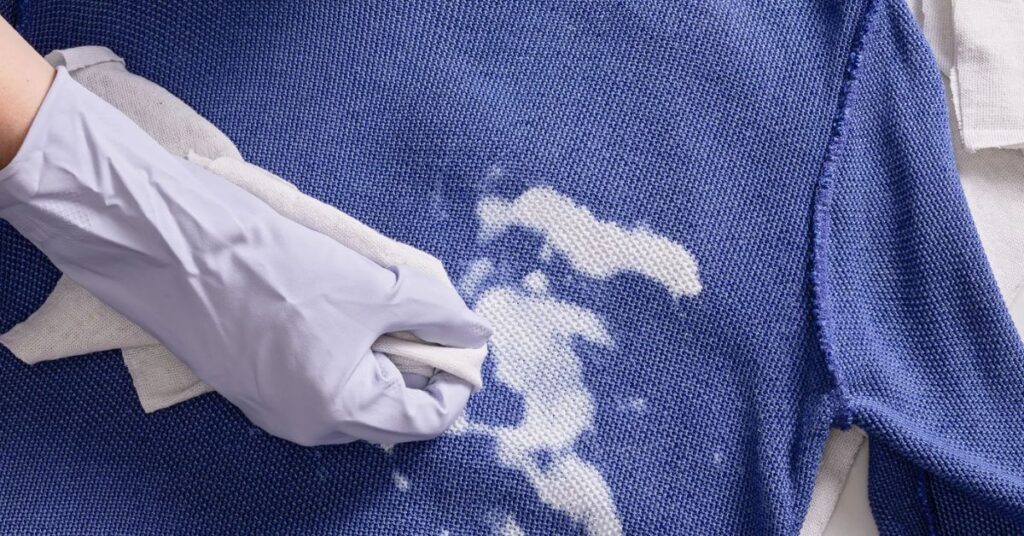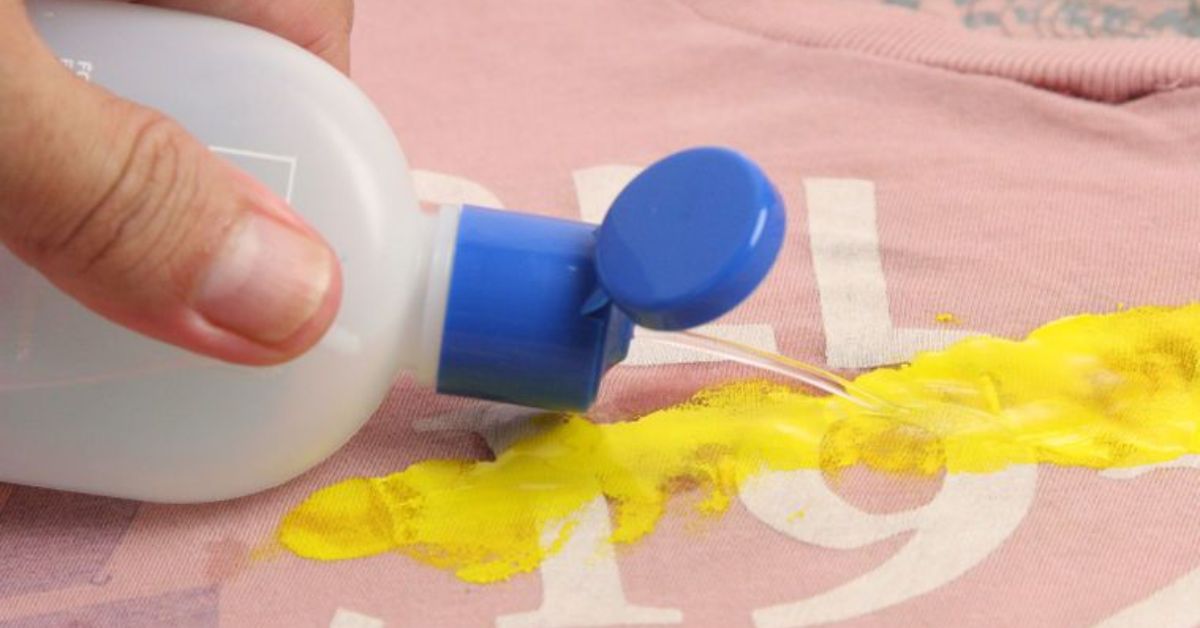Acrylic paint is a versatile medium loved by artists and crafters alike, but it can be a nightmare when it ends up on your clothes.
Whether you’re a professional painter or a weekend DIY enthusiast, accidents happen, and knowing how to remove acrylic paint from fabric can save your favorite garments from ruin. This guide will walk you through various methods to tackle acrylic paint stains, from fresh spills to dried-on messes.
Understanding the Challenge of Acrylic Paint Stains

Acrylic paint is popular for its quick-drying properties and durability, but these same qualities make it challenging to remove from fabric. Unlike water-based paints, acrylic paint forms a plastic-like film when dry, adhering strongly to fibers.
Composition of Acrylic Paint
Acrylic paint consists of pigments suspended in an acrylic polymer emulsion. When the paint dries, the polymers form strong bonds, creating a flexible but durable coating. This is great for artwork but problematic for clothing stains.
Factors Affecting Removal
Several factors influence the difficulty of removing acrylic paint:
- Drying time: Fresh paint is easier to remove than dried paint.
- Fabric type: Synthetic fabrics may resist staining more than natural fibers.
- Paint color: Darker pigments can be more stubborn than lighter ones.
- Fabric texture: Rough textures can trap more paint than smooth surfaces.
Understanding these factors helps in choosing the most effective removal method.
Immediate Actions to Take When Acrylic Paint Spills

Quick action is crucial when dealing with acrylic paint spills on clothing. The faster you respond, the better your chances of successful removal.
- Blot, don’t rub: Use a clean cloth or paper towel to blot excess paint. Rubbing can spread the stain and push paint deeper into the fabric.
- Keep the stain wet: Acrylic paint is much easier to remove when wet. If possible, hold the stained area under running water to prevent drying.
- Remove excess paint: Gently scrape off any thick globs of paint using a spoon or dull knife.
- Act fast: Time is of the essence. The longer the paint sits, the harder it becomes to remove.
- Isolate the stain: If possible, place a piece of cardboard between layers of fabric to prevent the paint from transferring to other areas.
These immediate steps can significantly improve your chances of completely removing the paint stain.
READ THIS BLOG: How To Get Tree Sap Out Of Clothes?
Pre-Treating Acrylic Paint Stains for Effective Removal
Pre-treatment is a crucial step in tackling acrylic paint stains, especially if the paint has begun to dry.
Softening Dried Paint
For dried paint:
- Saturate the stain with isopropyl alcohol or hand sanitizer.
- Let it sit for 15 minutes to soften the paint.
- Use a soft-bristled brush to gently work the alcohol into the fibers.
Creating a Pre-Treatment Solution
Mix equal parts dishwashing liquid and warm water. This solution can help break down the paint’s binding agents.
- Apply the solution generously to the stain.
- Gently work it into the fabric with your fingers or a soft brush.
- Let it sit for 15-20 minutes before proceeding with removal techniques.
Pre-treating helps loosen the paint’s hold on the fabric, making subsequent removal steps more effective.
Using Rubbing Alcohol to Remove Dried Acrylic Paint

Rubbing alcohol (isopropyl alcohol) is one of the most effective solvents for removing dried acrylic paint from fabric.
Here’s how to use it:
- Test on an inconspicuous area first to ensure it won’t damage the fabric.
- Soak a cotton ball or clean cloth in rubbing alcohol.
- Dab the stained area, working from the outside towards the center.
- As the paint loosens, blot with a clean, damp cloth to lift the paint.
- Repeat the process, changing to clean sections of the cloth as needed.
- For stubborn stains, try soaking the affected area in alcohol for 15-20 minutes.
Remember to rinse the area thoroughly with cold water after treatment to remove any residual alcohol.
How to Apply Dish Soap and Warm Water to Loosen Paint?

For fresh or slightly dried paint stains, a combination of dish soap and warm water can be surprisingly effective.
Follow these steps:
- Mix a solution of one part dish soap to one part warm water.
- Apply the solution directly to the paint stain.
- Use your fingers or a soft-bristled brush to work the solution into the fabric gently.
- Let it sit for 15 minutes to allow the soap to penetrate the paint.
- Rinse with warm water, blotting the area to lift away loosened paint.
- Repeat the process if necessary, focusing on any remaining paint spots.
This method is particularly useful for water-based acrylic paints and can be a good first step before trying more aggressive removal techniques.
Techniques for Removing Acrylic Paint from Delicate Fabrics

Delicate fabrics like silk, wool, or certain synthetics require extra care when removing acrylic paint to avoid damage.
Consider these gentle techniques:
- Use a mixture of lukewarm water and mild detergent specifically designed for delicate fabrics.
- Apply the solution gently using a soft cloth or sponge, being careful not to rub too hard.
- For wool, consider using a wool-safe soap instead of regular detergents.
- For silk, try a solution of equal parts white vinegar and water, applying it gently with a soft cloth.
- Always test any cleaning solution on an inconspicuous area first.
- After treating, rinse thoroughly with cool water and air dry.
If you’re unsure about treating a delicate garment yourself, consider seeking professional dry cleaning services.
Using Commercial Stain Removers for Tough Paint Stains

For particularly stubborn acrylic paint stains, commercial stain removers can be highly effective.
Some recommended products include:
- Motsenbocker’s Lift Off: Specifically formulated for latex and acrylic paints.
- Goof Off: Effective on various types of paint and adhesives.
- Krud Kutter: A versatile cleaner that can tackle tough paint stains.
When using these products:
- Always test on an inconspicuous area first.
- Follow the manufacturer’s instructions carefully.
- Work in a well-ventilated area, as some products have strong fumes.
- Wear gloves to protect your skin.
- Rinse thoroughly after treatment and wash the garment as usual.
Commercial removers can be powerful allies in tackling set-in or particularly stubborn acrylic paint stains.
READ THIS BLOG: How To Get Sticker Residue Off Clothes?
Final Steps: Washing and Drying Clothes After Paint Removal
After successfully removing the acrylic paint, proper washing and drying are crucial to ensure all traces of paint and cleaning agents are removed from the fabric.
Follow these steps:
- Pre-treat any remaining stains with a stain remover or laundry detergent.
- Wash the garment in the hottest water safe for the fabric (check the care label).
- Add an extra rinse cycle if possible to ensure all cleaning agents are removed.
- Inspect the garment before drying. If any paint remains, repeat the removal process.
- Air dry the garment if possible, as heat from a dryer can set any remaining paint residue.
- Once completely dry, check again for any lingering stains or discoloration.
By following these washing and drying techniques, you can ensure your garment is thoroughly cleaned and restored to its original condition.
FAQs
Can hairspray remove acrylic paint from clothes?
While hairspray containing alcohol can help, it’s not as effective as pure rubbing alcohol and may leave its own residue. It’s better to use isopropyl alcohol directly.
Is acrylic paint permanent on clothes once it dries?
While dried acrylic paint is challenging to remove, it’s not always permanent. With the right techniques, even dried paint can often be removed or significantly reduced.
Can I use acetone to remove acrylic paint from fabric?
Acetone can be effective but may damage or discolor certain fabrics. It’s best to test on an inconspicuous area first and use caution.
How do I remove acrylic paint from shoes?
Use similar techniques as for clothing, but be extra cautious with materials like leather or suede. A soft brush and rubbing alcohol can be effective for most shoe materials.
Will vinegar remove dried acrylic paint?
Vinegar can help soften dried acrylic paint but is generally not as effective as alcohol-based solutions. It may be useful as part of a pre-treatment process.
Conclusion
Removing acrylic paint from clothes can be challenging, but with the right techniques and a bit of patience, it’s often possible to salvage stained garments. The key is to act quickly, choose the appropriate method based on the fabric type and paint condition, and be persistent in your efforts.Remember to always test removal methods on an inconspicuous area first and to be gentle to avoid damaging the fabric.
By following the steps outlined in this guide, from immediate actions to final washing techniques, you can tackle even stubborn acrylic paint stains and keep your clothes looking their best. With these tools and knowledge at your disposal, you can confidently handle paint accidents and continue enjoying your artistic pursuits without fear of ruining your wardrobe.

Hayyat is an experienced content writer and digital marketer, skilled in creating SEO-friendly content that resonates with audiences. She helps brands enhance their online presence through targeted campaigns, with expertise in blog writing, social media management, email marketing, and SEO optimization.





